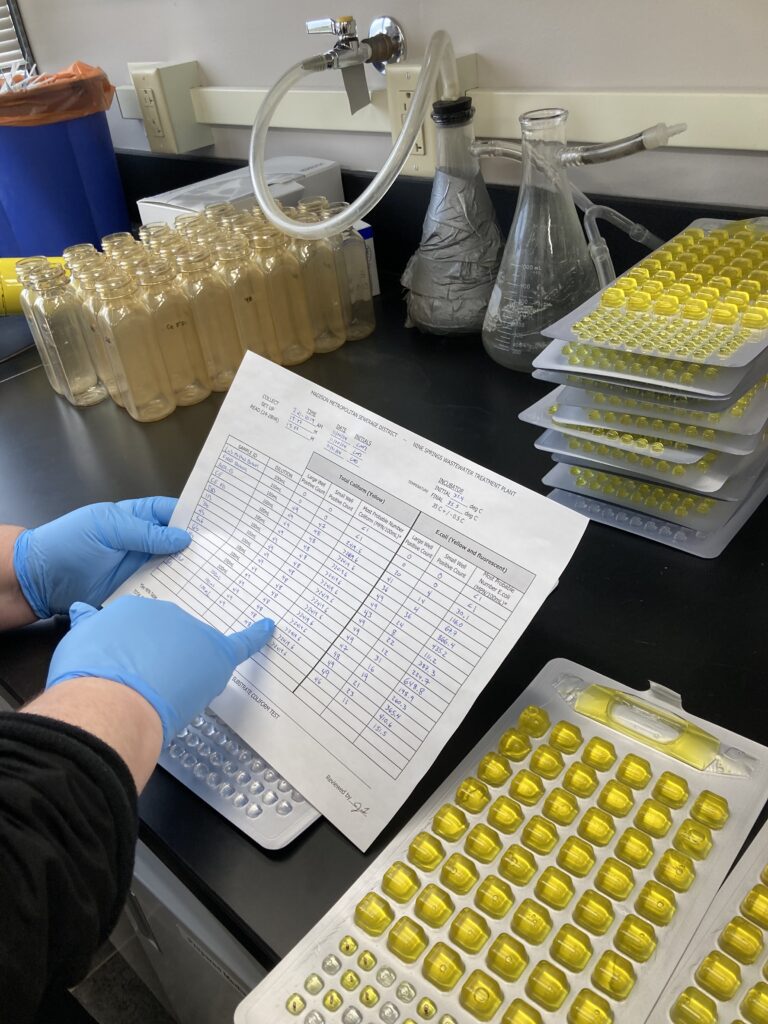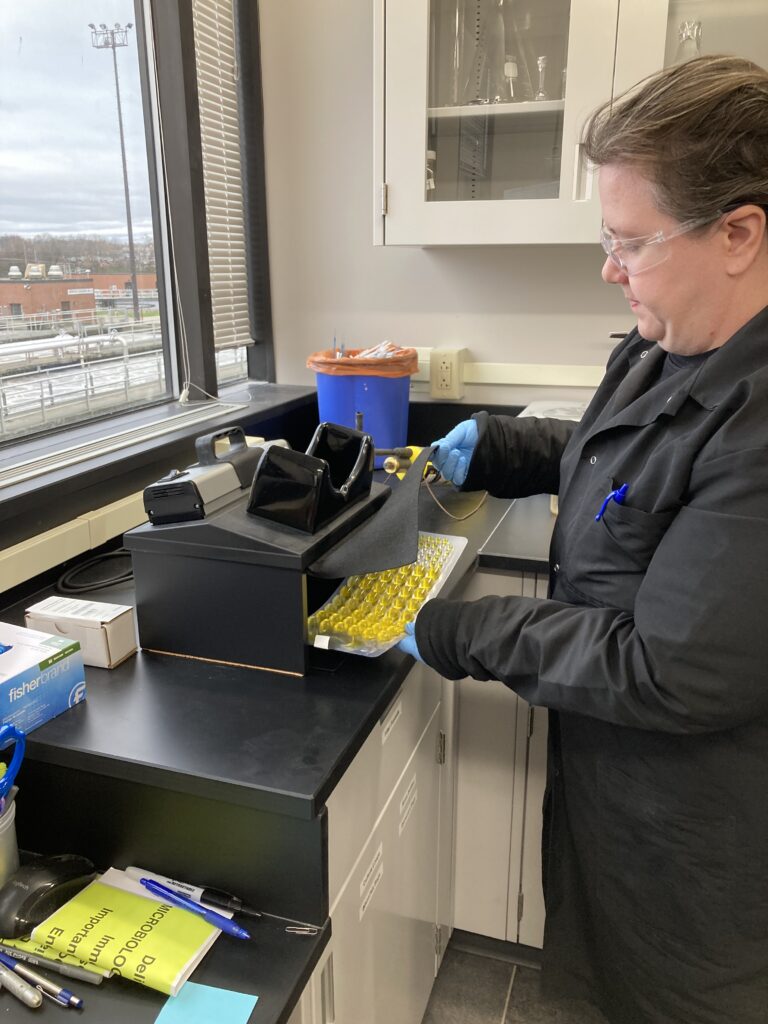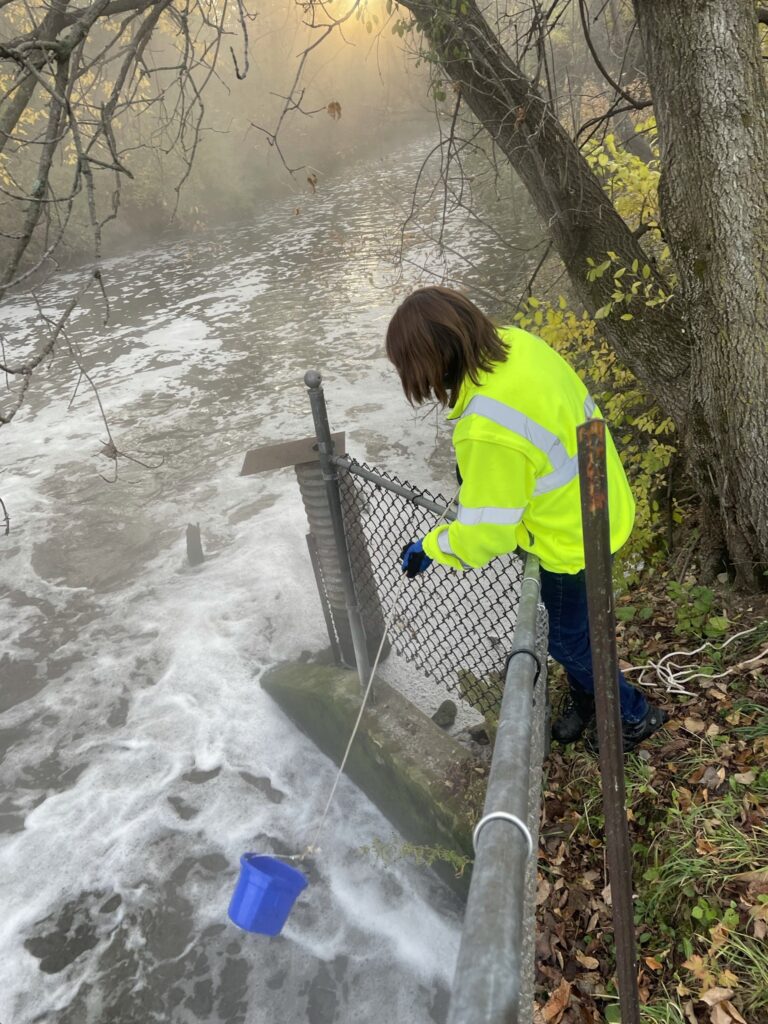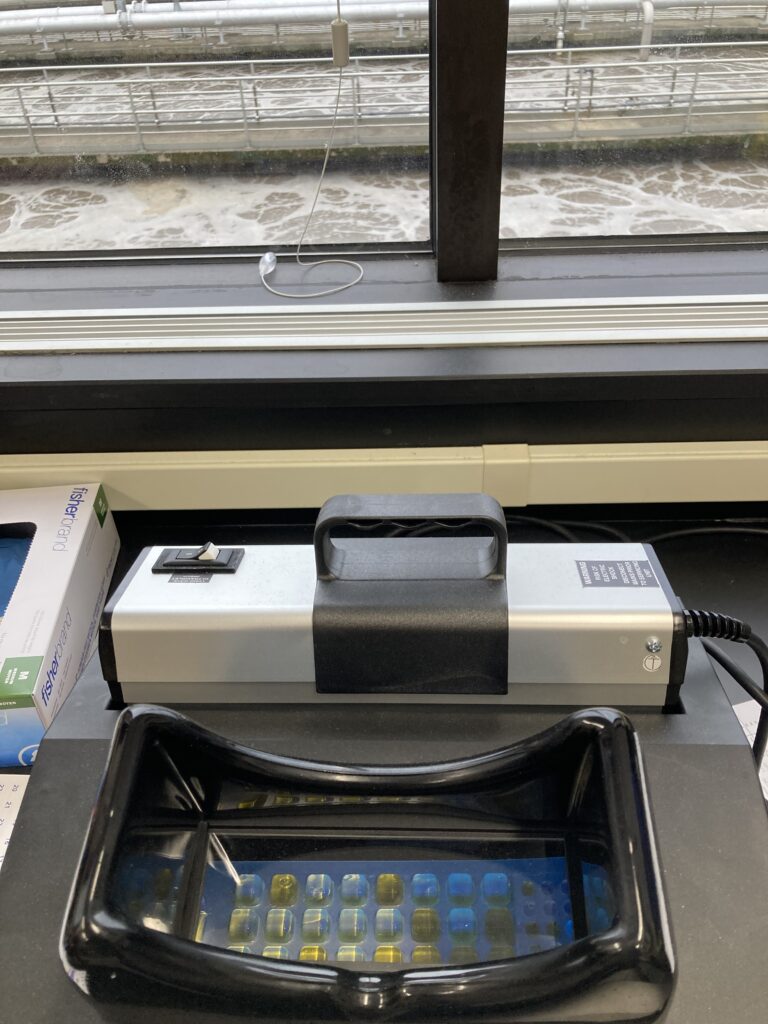
In the spring of 2024, the District’s lab changed its method of analyzing bacteria in water samples and the results are glowing. Glowing because it involves fluorescence and it’s been a success, and because, well, what’s not a little awe-inspiring about fluorescent things?
The new (to us) method provides substantial and practical improvements to efficiency in the lab. District chemist Lisa Brandt, who runs the lab’s bacteria section, proposed the change. She used the method in her previous wastewater lab job and knew the labor and time savings it provided.
It’s also the method used by fellow regional wastewater labs. “This brings us in line with what other wastewater labs in the state are doing, as well as drinking water labs like the State Lab of Hygiene,” says Lisa. “There is something to be said for keeping to the more standardized method.”
Growing vs. glowing
The method the lab historically used for analyzing fecal coliform is called a membrane filtration method, which involves filtering a water sample through a membrane, placing it on a culture media, and analyzing the bacteria that grow after incubation. The new method is referred to as the IDEXX method by those in the know (after the name of the test product manufacturer), but its technical name is a multiple tube/multiple well approach.
“The IDEXX method uses a different philosophy,” says Lisa. “Instead of taking your sample and seeing what grows, it interacts with enzymes the bacteria release as they break down the organic matter and reproduce.” This interaction turns a colorless water sample yellow if coliform is present and fluorescent if E. coli is present.

New permit requirement drives change
The opportunity to change to the IDEXX method came after the Wisconsin Department of Natural Resources (DNR) announced it would require the District’s effluent to be monitored for E. coli instead of fecal coliform as part of our permit reissuance process, expected to result in a new permit in 2025. While the membrane filtration method could technically be used to monitor for E. coli, it was not as efficient.
“The method for measuring E. coli that was on the books here but not in use involved a multi-step process with two different growing media incubating in two four-hour stages,” says Lisa. “With the IDEXX method, you get right to it.”
Bacteria 101
Coliform bacteria are a group of bacteria within the Enterobacteriaceae family, a large group of bacteria types found in soil and water. Fecal coliform, or F. coli, is a type of bacteria in the coliform group, and E. coli is a subset of fecal coliform. “Coliforms are an indicator species,” explains Lisa, “if you see these species then it is possible that other harmful bacteria or pathogens are present as well.”
E. coli, as most of us know, can be one of those more harmful types of bacteria within the F. coli group. Research done by the U.S. EPA in recent years led the agency to conclude that testing specifically for E. coli is the best way to assess health risks in fresh water. The DNR changed its water quality criteria from F. coli to E. coli to meet this recommendation in 2020 and has been rolling out the change when issuing new permits to treatment plants.
Martye Griffin, director of ecosystem services says that changing the requirement from F. coli to E. coli monitoring brings the wastewater industry into the more standardized criteria. “In general, the bacteria standard for any type of environmental contamination is E. coli, so it’s finally caught up to the wastewater industry,” he says.
District water sampling programs overview

The lab runs three water sampling programs to monitor for bacteria – one that is required by our permit and two that are public trust programs (i.e. not required under the permit but done in the interest of the District and for the benefit of the community). The combined effluent (CE) analysis is performed twice per week during the disinfection season (March through November) for our permit requirements.
The two public trust programs are the stream sampling program, which monitors the bacteria levels in the Badfish and Badger Mill creeks monthly, and the annual summer home well testing program, which tests private well water for residential properties adjacent to farm fields where Metrogro biosolids are applied as fertilizer.
Benefits of switching all programs to monitor for E. Coli
While there is no requirement for the home well or stream sampling programs to switch from F. coli to E. coli monitoring, the benefit of switching these public trust programs to the more efficient IDEXX method had the biggest impact on Lisa’s workload. Annually, she performs 292 stream sampling analyses and over 500 home well tests, compared to 78 CE tests. She says that using the same method for all the water bacteria tests means less labor, time and materials.
The IDEXX method also has a 24-hour result turnaround time vs. a four-day turnaround with the membrane filtration method. This time savings has the biggest impact on the home well program because residents can know the status of their well water faster and any re-sampling can be done more efficiently by lab staff.
Lab manager Mary Powers says that wet years can result in a lot more bacteria-positive well test results that then require re-sampling. “If we hadn’t used the IDEXX method in 2024 Lisa still might have been re-testing in December,” she says.
Mary says Lisa made the transition to switching all the programs to IDEXX seamless and sees a benefit for the lab as a whole. “It definitely gives Lisa more time to be able to help out in other sections and get to her other ancillary tasks like documentation and quality control,” she says.
Comparable data makes for more meaningful data

Martye also sees another benefit to having the criteria be E. coli vs. F. coli. “The data we generate now is comparable – now when we give a home well resident an E. coli number it is something they can understand because if they talk to public health or even google information on it, it’s always going to be an E. coli standard.” This also applies to the stream sampling data as well, says Martye. “For example, if we wanted to compare our stream data to the City of Madison’s beach monitoring data, it would be comparable.”
Fluorescent application
The verdict on switching to the IDEXX method is clear for everyone involved – there are almost no cons and the District’s performance of the method has now been tested and approved by the DNR for when the new permit is issued.
The good news is that we are using the new method now for home well and stream samples; the bad news is that Lisa will have to continue to perform the F. coli test for the CE samples until the reissued permit officially allows us to report E. coli data.
As for Lisa’s experience with seeing “glowy” things all day, she has mixed feelings. “It’s neat,” she says of the science behind the fluorescent result, “but it’s also something you’re hoping not to see, especially on the home well tests, so it’s mixed.”
By Jessica Spiegel






